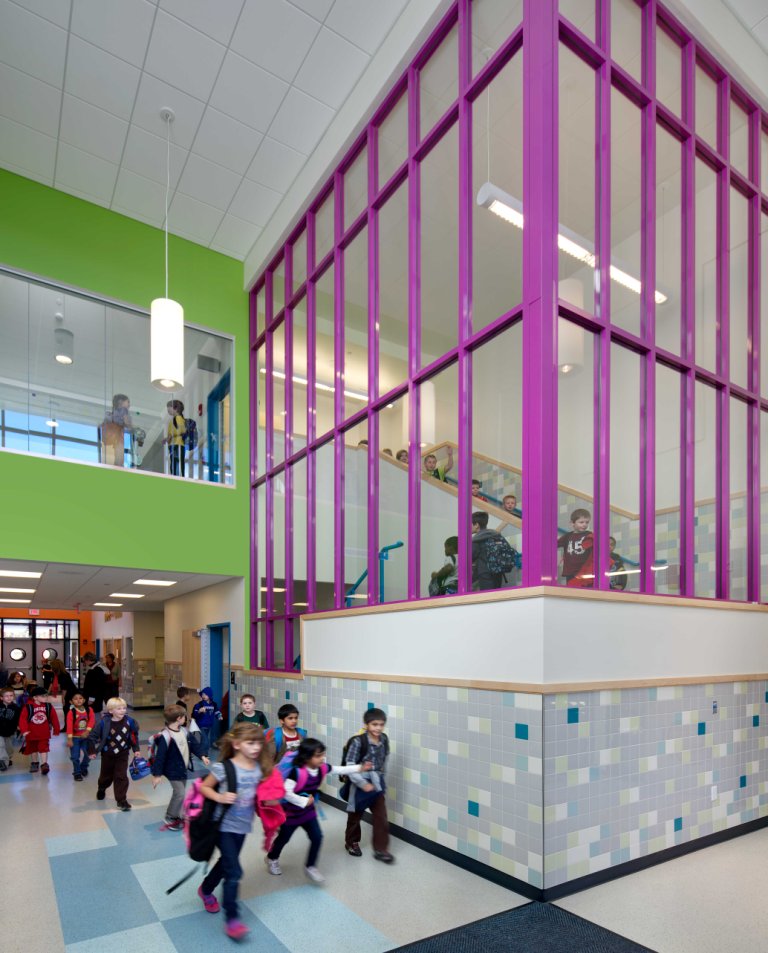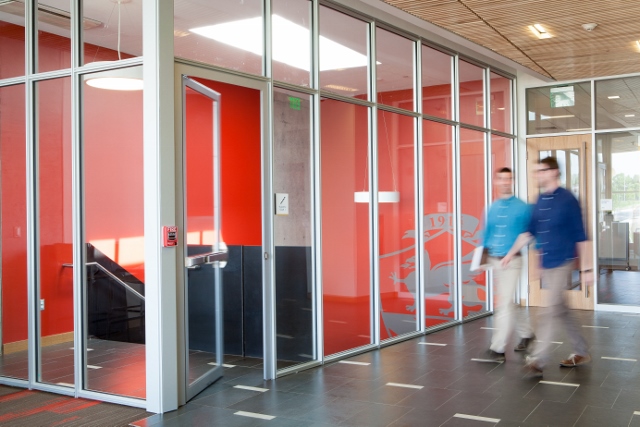As more students enter the school system each year, designing for fire safety in educational facilities has never been more critical. Fire-rated glazing can be a key part of the solution. With proper specification, it can defend against the spread of fire, resist impact from rambunctious students and transfer natural light into learning areas, which can improve student performance.1
A case in point is the design and development of an egress stairwell in Concord, New Hampshire's Mill Brook Elementary School. To support the school’s vision for developing a multi-use “learning corridor” that brings education beyond the classroom, HMFH Architects designed the fire-rated stairwell to be bright and open, reflecting the playful energy of students. They achieved this goal by pairing Fireframes® Aluminum Series fire-resistant frames with Pilkington Pyrostop® fire-resistant glass, both supplied by Technical Glass Products (TGP).
Rather than the bulky, wrap-around frames often associated with traditional fire-rated framing systems, the Fireframes Aluminum Series fire-rated frames have slender profiles that can be custom wet painted, anodized or powder coated in nearly any color. In this application, the narrow fire-rated frames were powder coated a bright purple to match the interior color scheme—a key aesthetic benefit since learning areas are integrated into public spaces outside student classrooms.
Pilkington Pyrostop fire-resistant glazing allowed the design team to incorporate unrestricted amounts of transparent glazing in the stairwell to improve light transfer. The product also offers fire-ratings of up to two hours, and blocks the transfer of radiant heat, providing essential protection should students need to exit the building during a fire. Pilkington Pyrostop meets the impact requirements of CPSC 16CFR1201 Category I and/or Category II – a critical performance benefit for glass used in busy stairwells.
TGP’s Fireframes Aluminum Series fire-rated frames with Pilkington Pyrostop transparent fire-rated glazing also proved beneficial during the renovation of Johnson & Wales University Center for Physician Assistant Studies. The building’s lack of openness and accessibility to the street was a concern for DBVW Architects during the design phase. “The original main entrance to the building was not handicap accessible and not as grand as we envisioned for Johnson & Wales’ new Physician Assistant Program,” explains Sean Redfern, associate principle for DBVW Architects.

Bright purple fire-rated egress stairwell at Mill Brook Elementary School
For the lobby and stairs to satisfy building codes and successfully work together to create a clear circulation path for students and faculty entering the school, DBVW Architects paired the Fireframes Aluminum Series fire-rated frames with Pilkington Pyrostop transparent fire-rated glazing.
“Together, the thin profile design of TGP’s Fireframes Aluminum Series fire-rated frames and clear Pilkington Pyrostop fire-rated glass helped us achieve the transparency and fire protection we were looking for in the space,” explains Sean Redfern, associate principle for DBVW Architects. “Using fire rated glass for an entire exit stair enclosure isn’t something you see every day. But the openness that TGP’s fire-rated frames and glass created fit well with our design aspirations.”
For more information on how to select first-class glass solutions that can support fire and life safety protection and student wellbeing goals in schools, please visit fireglass.com.
1Sapna Cheryan, Sianna A. Ziegler, Victoria C. Plaut, and Andrew N. Meltzoff. Designing Classrooms to Maximize Student Achievement. Policy Insights from the Behavioral and Brain Sciences, 2014
Windows and Classrooms: A Study of Student Performance and the Indoor Environment, a 2003 study conducted by the Heschong Mahone Group.
Technical Glass Products
800.426.0279
800.451.9857 – fax
sales@fireglass.com
www.fireglass.com
Related Stories
| May 18, 2011
One of Delaware’s largest high schools seeks LEED for Schools designation
The $82 million, 280,000-sf Dover (Del.) High School will have capacity for 1,800 students and feature a 900-seat theater, a 2,500-seat gymnasium, and a 5,000-seat football stadium.
| May 17, 2011
Sustainability tops the syllabus at net-zero energy school in Texas
Texas-based firm Corgan designed the 152,200-sf Lady Bird Johnson Middle School in Irving, Texas, with the goal of creating the largest net-zero educational facility in the nation, and the first in the state. The facility is expected to use 50% less energy than a standard school.
| May 16, 2011
USGBC and AIA unveil report for greening K-12 schools
The U.S. Green Building Council and the American Institute of Architects unveiled "Local Leaders in Sustainability: A Special Report from Sundance," which outlines a five-point national action plan that mayors and local leaders can use as a framework to develop and implement green schools initiatives.
| May 10, 2011
Greenest buildings: K-12 and commercial markets
Can you name the nation’s greenest K-12 school? How about the greenest commercial building? If you drew a blank, don’t worry because our friends at EarthTechling have all the information on those two projects. Check out the Hawai’i Preparatory Academy’s Energy Lab on the Big Island and Cascadia Green Building Council’s new Seattle headquarters.
| Mar 15, 2011
Passive Strategies for Building Healthy Schools, An AIA/CES Discovery Course
With the downturn in the economy and the crash in residential property values, school districts across the country that depend primarily on property tax revenue are struggling to make ends meet, while fulfilling the demand for classrooms and other facilities.
| Feb 23, 2011
“School of Tomorrow” student design competition winners selected
The American Institute of Architecture Students (AIAS) and Kawneer Company, Inc. announced the winners of the “Schools of Tomorrow” student design competition. The Kawneer-sponsored competition, now in its fifth year, challenged students to learn about building materials, specifically architectural aluminum building products and systems in the design of a modern and creative school for students ranging from kindergarten to sixth grade. Ball State University’s Susan Butts was awarded first place and $2,500 for “Propel Elementary School.”
| Feb 15, 2011
LAUSD commissions innovative prefab prototypes for future building
The LA Unified School District, under the leadership of a new facilities director, reversed course regarding prototypes for its new schools and engaged architects to create compelling kit-of-parts schemes that are largely prefabricated.
| Feb 9, 2011
Gen7 eco-friendly modular classrooms are first to be CHPS verified
The first-ever Gen7 green classrooms, installed at Bolsa Knolls Middle School in Salinas, California, have become the nation's first modular classrooms to receive Collaborative for High Performance Schools (CHPS) Verified recognition for New School Construction. They are only the second school in California to successfully complete the CHPS Verified review process.
| Dec 17, 2010
Alaskan village school gets a new home
Ayagina’ar Elitnaurvik, a new K-12 school serving the Lower Kuskikwim School District, is now open in Kongiganak, a remote Alaskan village of less than 400 residents. The 34,000-sf, 12-classroom facility replaces one that was threatened by river erosion.
| Dec 6, 2010
Honeywell survey
Rising energy costs and a tough economic climate have forced the nation’s school districts to defer facility maintenance and delay construction projects, but they have also encouraged districts to pursue green initiatives, according to Honeywell’s second annual “School Energy and Environment Survey.”















